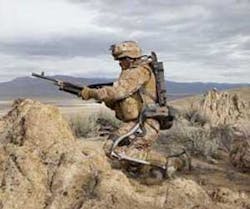Exoskeleton technology reduces soldier fatigue and injury
By John McHale
ORLANDO, Fla.–Today’s foot soldier has to carry more electronics gear over rough terrain than any warfighter in history. The technology provides untold advantages over the enemy–but it is not by any means a light load.
Reducing warfighter fatigue and injuries is the purpose of the Human Universal Load Carrier (HULC) exoskeleton–a joint effort between engineers at Lockheed Martin Missiles and Fire Control in Orlando, Fla., and Berkeley Bionics in Berkeley, Calif.
“The HULC system is an untethered, hydraulic-powered anthropomorphic exoskeleton–where normal movement is not inhibited,” says Adam Miller, director of new initiatives for business strategy and development at Lockheed Martin Missiles and Fire Control. “It’s about safety for the soldier,” he adds.
“We saw the utility of it and got into a discussion with Berkeley,” Miller says. Berkeley provided the exoskeleton and Lockheed Martin provided ruggedization–“it is the perfect marriage of capabilities,” he adds.
Soldiers can use the exoskeleton to carry front and back loads weighing as much as 200 pounds–in addition to HULC’s own weight of 53 pounds, says James Ni, program manager at Lockheed Martin Missiles and Fire Control. The HULC’s load-carrying ability will also work without electric power, he adds.
The system essentially transfers the carried weight to the ground through powered titanium legs, Miller says. Operators can lift, crawl, and do deep squats.
The HULC is adjustable to fit soldiers between five feet four inches and six feet two inches, Ni says. Research showed that the majority of solders fall between those heights, he adds.
Berkeley designed the electronics for the HULC, which include a custom single-board computer that controls the system and keeps the exoskeleton’s movements in line with the soldier’s, Miller says. The HULC system can withstand temperatures as hot as 125 degrees Fahrenheit.
The HULC is powered by lithium polymer batteries–a 60-volt system that can draw peaks as high as 100 amps. The system runs at 250 watts, but powers down when the soldier is not moving, Ni says.
Each four-pound battery pack allows for a one-hour trip at normal walking speeds of three miles per hour. The maximum speed is 7 miles per hour–about marathon running speed–for a long duration, with a burst speed of 10 miles per hour–about the speed of a competitive 5K road race runner–Miller says.
“We have an exclusive licensing agreement with Berkeley Bionics on the HULC,” Ni says. Berkeley originally developed the HULC system with funding from the Defense Advanced Research Projects Agency (DARPA) in Arlington, Va., to come up with an exoskeleton capability for soldiers, he adds.
The goal of that DARPA investment was to decrease the warfighter’s “metabolic cost,” according to Berkeley’s Web site (www.berkeleybionics.com).
During early Berkeley evaluations the oxygen consumption of the users walking at a speed of 2 miles per hour was decreased by 5 percent to 12 percent when using their initial test unit without a payload, according to the Berkeley Web site. “When the users carried a load, the effect was more pronounced. The oxygen consumption of these users carrying an 81-pound approach load at a speed of 2 miles per hour was decreased by about 15 percent when using the prototype HULC.”
The HULC is also a modular system, enabling warfighters to easily swap out attachments and components in the field, Miller says.
According to the Lockheed HULC data sheet, the system has attachments for lifting heavy objects such as artillery shells, for a SWAT ballistic missile shield, and has a foldable kit to carry a combat casualty patient.
Currently the system is being demonstrated in a controlled environment, Miller says. The next step around the beginning of next year is to demonstrate a prototype in an operational environment, he continues.
Miller notes that they have also had talks with the U.S. Army’s Natick Soldier Systems’ Center in Natick, Mass, on how the HULC would work with the center’s Future Force Warrior program. The discussions are in the early stages but there are some potential synergies, he adds.
The goal is to get the HULC to the Army quickly to “ride the wave of initial investment,” Miller says.

